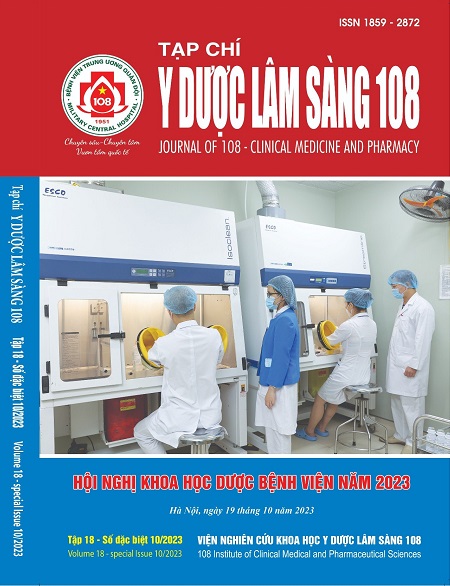The status of antibiotics use in the treatment of community-acquired pneumonia in children aged two months to 5 years at the Nghe An Obstetrics and Pediatrics Hospital in 2022
Main Article Content
Keywords
Abstract
Objective: To describe the use of antibiotics in the treatment of community-acquired pneumonia in children aged two months to 5 years at the Respiratory Department of Nghe An Obstetrics and Pediatrics Hospital in 2022. Subject and method: A cross-sectional study was retrospectively conducted on 215 medical records of inpatients at the Respiratory Department, with discharge dates from October 1, 2022, to December 31, 2022. Result: Among 215 patients, 87% were diagnosed with pneumonia, and 13% had severe pneumonia. Comorbidities were primarily related to the upper respiratory tract. 47% of the patients had used antibiotics before being hospitalized. Microbiological tests through nasopharyngeal fluid were indicated in 6% of the patients. Third-generation cephalosporins were the primary antibiotic used in the initial treatment protocol, and 94.4% of the initial treatment protocols complied with recommendations. Carbapenem + vancomycin was the primary alternative protocol (28.5%). Two patients with impaired renal function were treated with higher doses than recommendations. 98.6% of patients recovered and improved symptoms when being discharged. Conclusion: Third-generation cephalosporins were the most commonly prescribed antibiotics to initially treat community-acquired pneumonia. Doses for patients with impaired renal function should be adjusted carefully to ensure safety
Article Details
References
2. World Health Organization. Pneumonia in children. Geneva: World Health Organization 2022. Truy cập ngày 14/6/2023. https://www.who.int/news-room/fact-sheets/detail/pneumonia.
3. Nelson JD (2000) Community-acquired pneumonia in children’s guidelines for treatment. Pediatr Infect. Dis. J. 19(3): 251-253.
4. Alzomor O, Alhajjar S et al (2017) Management of community-acquired pneumonia in infants and children: Clinical practice guidelines endorsed by the Saudi Pediatric Infectious Diseases Society. International journal of pediatrics and adolescent medicine 4(4): 153-158.
5. Trần Thị Kiều Anh, Nguyễn Văn Tuấn (2021) Nghiên cứu tính kháng kháng sinh của vi khuẩn gây viêm phổi ở trẻ 2 tháng đến 5 tuổi tại Bệnh viện Sản Nhi Nghệ An năm 2021. Tạp chí Y học Việt Nam tập 507 số 2, tr. 297-301.
6. Bệnh viện Sản Nhi Nghệ An (2020) Phác đồ chẩn đoán và điều trị bệnh lý nhi khoa, Nghệ An. Bệnh viện Sản Nhi Nghệ An.
7. Hofto ME, Samuy N, Pass RF (2022) Antibiotic use and outcomes in young children hospitalized with uncomplicated community-acquired pneumonia. Open Forum Infectious Diseases 9(4): ofac123.
8. Phạm Thu Hà (2018) Phân tích tình hình sử dụng kháng sinh trong điều trị viêm phổi cộng đồng tại Bệnh viện Nhi Trung ương. Luận văn Thạc sĩ Dược học. Trường Đại học Dược Hà Nội.
9. Bộ Y tế (2015) Sử dụng kháng sinh trong điều trị viêm phổi cộng đồng của trẻ em. Nhà xuất bản Y học, tr. 82-84.
10. Hồ Thị Ngọc Thảo (2022) Nghiên cứu tình hình sử dụng kháng sinh điều trị trên trẻ em mắc viêm phổi tại Khoa Nhi - Bệnh viện Bạch Mai. Khóa luận tốt nghiệp Dược sỹ đại học, Trường đại học Y Dược – Đại học Quốc gia Hà Nội.
11. Gian MP, Giovanna M (2020) Clinical Pharmacology of amikacin in infants and children. Clinical and Medical Investigations 5: 1-14.
 ISSN: 1859 - 2872
ISSN: 1859 - 2872
